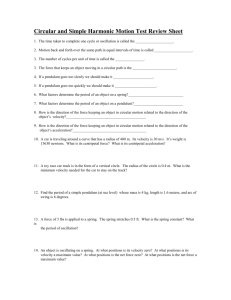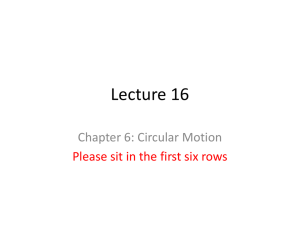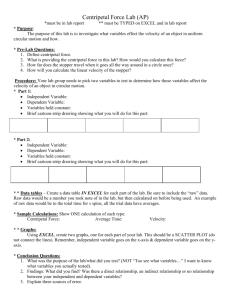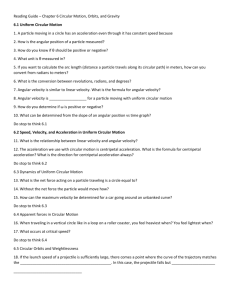centripetal force
advertisement
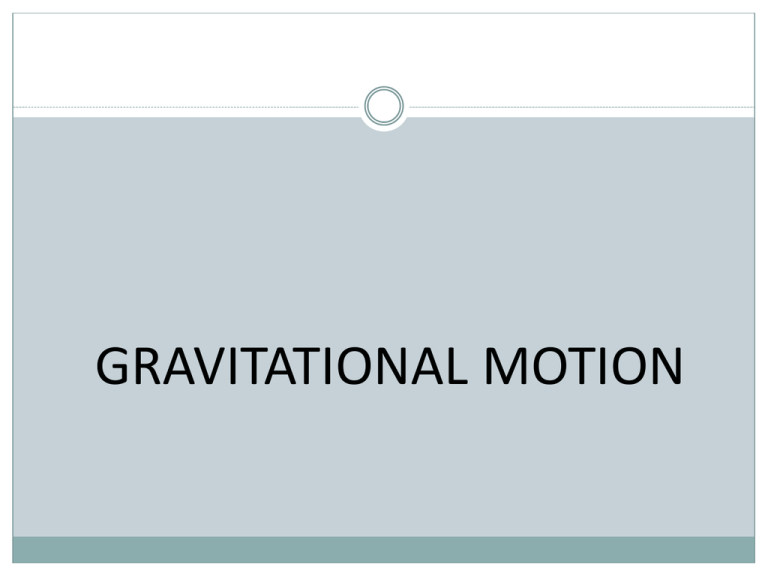
GRAVITATIONAL MOTION Newton’s Law of Universal Gravitation states that every particle in the universe attracts every other particle with a force that is directly proportional to the product of their masses and inversely proportional to the square of the distance between them. Gravity is a consequence of mass. The force of gravity between two objects is directly proportional to the product of the objects’ masses. The force of gravity between two objects is inversely proportional to the square of the distance between the two objects’ centers of mass. 𝑚1 𝑚2 𝐹=𝐺 𝑟2 Newton’s Law of Universal Gravitation Universal Constants Universal Gravitational Constant: 2 𝑁𝑚 −11 𝐺 = 6.67𝑥10 𝑘𝑔2 Mass of Earth: 24 𝑀𝐸 = 6𝑥10 𝑘𝑔 Radius of Earth: 𝑅𝐸 = 6.4𝑥106 𝑚 ACCELERATION DUE TO GRAVITY GMm F 2 R GMm mg 2 R GM g 2 R F Force of Gravitation G Universal Gravitational Constant M Mass of the Planet m mass of object R Radius of Planet So . . . g = ? Now work it out. Now work it out. Work that problem out. Get that problem right. Universal Gravitation #2 The mass of planet Jupiter is 1.9 x 1027 kg and that of the sun is 1.99 x 1030 kg. The mean distance of Jupiter from the sun is 7.8 x 1011m. Calculate the gravitational force which the sun exerts on Jupiter. m1 1.9 10 kg 27 m2 1.99 10 kg 30 G 6.67 10 11 Nm 2 / kg 2 r 7.8 1011 m m1 m 2 F G r2 (1.9 10 kg)(1.99 10 kg) (6.67 10 Nm / kg ) (7.8 1011 m ) 2 27 11 2 .4145 10 11 27 30 22 .4145 1024 N 4.145 1023 N 2 30 Where will the ball go? What will happen to the Moon? TORQUE Torque Torque Is the measure of how effectively a force causes rotation. τ Fr sinθ τ torque F force r distance θ angle Torques in equilibrium When the torques associated with two masses balance each other. τ1 - τ2 0 where : τ Fgr Torques in equilibrium Two people with the same mass. Which picture shows torques in equilibrium? A B Torques in equilibrium A – the distances are not the same in B so the torques will not balance. A B PROBLEM 1 Alfred weighs 400 N. He sits on one end of a seesaw 1.5 m from the fulcrum. Ann weighs 200 N. How far from the fulcrum must she sit to balance the seesaw? ? PROBLEM 1 F1 = 400 N r1 = 1.5 m F2 = 200 N r2 = ? 1 = 2 F1r1 = F2r2 400(1.5) = 200(r2) r2 = 3 m 3m 1.5 m CIRCULAR MOTION Linear Motion d – distance (in meters) v – velocity (in meters/second) a – acceleration (in meters/second2) Distance = 2r Linear/Tangential Velocity Objects moving in a circle still have a linear velocity = distance/time. This is often called tangential velocity, since the direction of the linear velocity is tangent to the circle. v Angular Motion – angular displacement (in radians) – angular velocity (in radians/second) – angular acceleration (in radians/second2) r – radius of circle (in meters) Circular Motion Terms The point or line that is the center of the circle is the axis of rotation. If the axis of rotation is inside the object, the object is rotating (spinning). If the axis of rotation is outside the object, the object is revolving. Angular Velocity Objects moving in a circle also have a rotational or angular velocity, which is the rate angular position changes. Rotational velocity is measured in degrees/second, rotations/minute (rpm), etc. Common symbol, (Greek letter omega) ∆𝜃 𝜔= ∆𝑡 D Rotational & Linear Velocity If an object is rotating: All points on the object have the same rotational (angular) velocity. All points on the object do not have the same linear (tangential) velocity. Linear velocity of a point depends on: The rotational velocity of the point. More rotational velocity means more linear velocity. The distance from the point to the axis of rotation. More distance from the axis means more linear velocity In symbols: v=r v r Linear to Angular d = r vT = r aT = r r Angular & Linear Velocity If an object is rotating: All points on the object have the same Angular velocity. All points on the object do not have the same linear (tangential) velocity. Angular & Linear Velocity Linear velocity of a point depends on: The Angular velocity of the point. More rotational velocity means more linear velocity. The distance from the point to the axis of rotation. More distance from the axis means more linear velocity. Acceleration As an object moves around a circle, its direction of motion is constantly changing. Therefore its velocity is changing. Therefore an object moving in a circle is constantly accelerating. Centripetal Acceleration The acceleration of an object moving in a circle points toward the center of the circle. This is called a centripetal (center pointing) acceleration. ac Centripetal Acceleration The centripetal acceleration depends on: The velocity of the object. The radius of the circle. 2 T v ac r 2 a c r vT Tangential Speed a c centripetal acceleration r radius of circular path angular velocity Circular Motion #8 A spinning ride at a carnival has an angular acceleration of 0.50 rad/s2. How far from the center is a rider who has a tangential acceleration of 3.3 m/s2? aT rα 3.3 r (.50) r 6.6m Circular Motion #9 What is the tire’s angular acceleration if the tangential acceleration at a radius of 0.15m is 9.4 x 10-2 m/s2? aT r .094 .15 .63rad / s 2 Circular Motion #10 A test car moves at a constant speed of 10 m/s around a circular road of radius 50 m. Find the car’s A) centripetal acceleration and B) angular speed. 2 A) B) 2 v (10) 2 ac 2m / s r 50 v 10 0.2rad / s r 50 Circular Motion #11 A test car moves at a constant speed around a circular track. If the car is 48.2 m from the track’s center and has a centripetal acceleration of 8.05 m/s2, what is its tangential speed? v rac 8.05 48.2 Givens : r 48.2m ac 8.05m / s vT ? 2 T 2 vT 8.05 48.2 19.7 m / s Circular Motion #12 A race car moves along a circular track at an angular speed of 0.512 rad/s. If the car’s centripetal acceleration is 15.4 m/s2, what is the distance between the car and the center of the track? Givens : .512rad / s ac 15.4m / s r ? 2 v ( r ) 2 ac r r r ac 15.4 r 2 58.7 m 2 (.512) 2 2 Circular Motion #13 A piece of clay sits 0.20 m from the center of a potter’s wheel. If the potter spins the wheel at an angular speed of 20.5 rad/s, what is the magnitude of the centripetal acceleration of the piece of clay on the wheel? Givens : 20.5rad / s r .20m ac ? a c r 2 (.20)(20.5) 84.05m / s 2 2 Tangential vs. Centripetal tangential and centripetal acceleration are perpendicular to one another. atotal a a 2 T ac tan aT 1 2 c ac aT θ atotal Equations for Circular Motion f i t 1 2 i t t 2 2 2 f i 2 i initial angular velocity(rad/s) f final angular velocity(rad/s) angular displacement(rad) angular acceleration(rad/s ) 2 t time(s) Angular Acceleration = 𝜟 𝜟𝒕 – angular velocity (radians/second) – angular acceleration (radians/second2) t – time (seconds) Circular Motion #14 A ventilator fan is turning at 600 rev/min when the power is cut off, and it turns 1000 rev while coasting to a stop. Calculate the angular acceleration and the time required to stop. i 600rev / min f 0rev / min 1000rev t ? ? 2 f i t 0 (600) 2 (1000) 2000 360000 0 600 (180)t t 3.33 min 2 f 2 i 2 180rev / min 2 Circular Motion #15 A bicycle wheel rotates with a constant angular acceleration of 3.5 rad/s2. If the initial speed of the wheel is 2 rad/s at t = 0 s. a) Through what angle does the wheel rotate in 2 s? b) what is the angular speed at t = 2 s? 1 2 i t t 2 1 2 2(2) (3.5)(2) 2 4 7 11rad f i t 2 (3.5)2 2 7 9rad / s Circular Motion #16 A potter’s wheel moves from rest to an angular speed of 0.20 rev/s in 30s. Find the angular acceleration in rad/s2. rev 2rad f 0.20 1.256rad / s s 1rev i 0rad / s f i t t 30 s ? rad / s 2 1.256 0 (30) .041rad / s 2 Circular Motion #16 A dentist’s drill starts from rest. After 3.20 seconds of constant angular acceleration it turns at a rate of 2.51 x 104 rev/min. a) find the drill’s angular acceleration. b) Determine the angle (radians) through which the drill rotates during this period. rev 2rad 1 min f 25100 2627.13rad / s min 1rev 60 s i 0rad / s t 3.2 s ? ? f i t 2627.13 0 (3.2) 821rad / s 2 1 2 i t t 2 1 2 0 (821)(3.2) 2 4203.52rad Circular Motion #18 A floppy disk in a computer rotates from rest up to an angular speed of 31.4 rad/s in a time of 0.892 s. A) What is the angular acceleration of the disk, assuming angular acceleration is uniform? B) How many revolutions does the disk make while coming up to speed? C) Find v if r = 4.45cm D) Find at if r = 4.45cm. i 0rad / s f 31.4rad / s t .892 s ? ? A) f i t 31.4 0 (.892) 35.2rad / s 2 1 2 1 2 B) i t t 0 (35.2)(.892) 14rad 2 2 1rev 14rad 2.23rev 2rad C )v r (.0445m)(31.4rad / s) 1.4m / s D)at r (.0445)(35.2rad / s 2 ) 1.57m / s 2 Centripetal Force Newton’s Second Law says that if an object is accelerating, there must be a net force on it. For an object moving in a circle, this is called the centripetal force. The centripetal force points toward the center of the circle. Centripetal Force In order to make an object revolve about an axis, the net force on the object must pull it toward the center of the circle. This force is called a centripetal (center Fc seeking) force. Centripetal Force Centripetal force on an object depends on: The object’s mass - more mass means more force. The object’s velocity - more speed means more force. And… Centripetal Force The centripetal force on an object also depends on: The object’s distance from the axis (radius). If linear velocity is held constant, more distance requires less force. If rotational velocity is held constant, more distance requires more force. Centripetal Force 2 t v 2 Fc mac m mrω r Fc centripeta l force (N) m mass (kg) v t tangential speed(m/s) r radius of circular path(m) ω angular speed(rad/ s) Fc vt Circular Motion #19 A test car moves at a constant speed of 10 m/s around a circular road of radius 50 m. Find the car’s A) centripetal acceleration and B) angular speed. vt 10m / s r 50m 2 t v 2 ac 2m / s r v 10 .2rad / s r 50 Circular Motion #20 A 0.015 kg rubber stopper is attached to 0.93 m length string. The stopper is swung in a horizontal circle, making one revolution in 1.18 seconds. A) find the speed of the stopper. B) find the force the string exerts on it. m 0.015kg r .93m 1rev 2rad 5.32rad / s 1.18s 1rev A)v r .93m 5.32rad / s 4.95m / s B) Fc mr 2 .015 .93 (5.32) 2 .4 N Circular Motion #21 A 50 kg runner moving at a speed of 8.8 m/s rounds a bend with a radius of 25 m. A) Find the centripetal acceleration of the runner B) what supplied the force needed to give this acceleration to the runner? m 50kg r 25m v 8.8m / s 2 t 2 v (8.8) 2 A)ac 3.09m / s r 25 vt2 8.82 B) Fc m 50 154.88 N r 25 “Centrifugal Force” “Centrifugal force” is a fictitious force - it is not an interaction between 2 objects, and therefore not a real force. Nothing pulls an object away from the center of the circle. What is erroneously attributed to “centrifugal force” is actually the action of the object’s inertia - whatever velocity it has (speed + direction) it wants to keep. As a car makes a turn, the force of friction acting upon the turned wheels of the car provide the centripetal force required for circular motion. As a bucket of water is tied to a string and spun in a circle, the force of tension acting upon the bucket provides the centripetal force required for circular motion. As the moon orbits the Earth, the force of gravity acting upon the moon provides the centripetal force required for circular motion. Without a centripetal force, an object in motion continues along a straight-line path. With a centripetal force, an object in motion will be accelerated and change its direction The tendency of a moving object to continue in a straight line in the absence of an unbalanced force and to turn in a circle in the presence of a inwarddirected force (i.e., centripetal force) has been experienced by any passenger in an automobile. When the car makes a sudden turn, the passengers tend to continue in their straight line path. This straight line motion continues until the presence of a side door or another passenger pushes upon the passenger in order to accelerate him/her towards the center of the turn. The force experienced by the passenger is an inward force; without it, the passenger would slide out of the car. Feelings of weightlessness and heaviness are associated with the normal force; they have little to do with the force of gravity. A person who feels weightless has not lost weight; the force of gravity acting upon the person is the same magnitude as it always is. Witness in the animation above that the force of gravity is everywhere the same. The normal force however has a small magnitude at the top of the loop (where the rider often feels weightless) and a large magnitude at the bottom of the loop (where the rider often feels heavy). The normal force is large at the bottom of the loop because in order for the net force to be directed inward, the normal force must be greater than the outward gravity force. At the top of the loop, the gravity force is directed inward and thus, there is no need for a large normal force in order to sustain the circular motion. The fact that a rider experiences a large force exerted by the seat upon her body when at the bottom of the loop is the explanation of why she feels heavy. In actuality, she is not heavier; she is only experiencing the large magnitude of force which is normally exerted by seats upon heavy people while at rest. Banking Curve When an automobile is driven around a sharp turn on a perfectly level road, friction between the tires and the road provides the centripetal force. If this centripetal force is not adequate, the car may slide off the road. The maximum speed with which a car can negotiate a turn of a given radius. Fs Force of Static Friction Fs Fc mv s mg r 2 v s g r v s rg 2 Fc Centripetal Force s Coefficient of Static Friction g gravity (9.8m/s ) r Radius m mass 2 Banking of a Cyclist A cyclist provides himself the necessary centripetal force by leaning inward on a horizontal track, while going around a curve. The cyclist should bend through an angle to have the necessary centripetal force while going around a curved path. 2 v 1 tan rg v velocity r radius g gravity (9.8m / s 2 ) Circular Motion #22 What is the maximum speed at which an automobile can negotiate a curve of radius 100m with out sliding, if the coefficient of static friction is 0.7? Fs Fc 2 mv s mg r 2 v s g r v s Rg (0.7)(100)(9.8) 26.1m / s Circular Motion #23 A car travels at a constant speed of 13.4 m/s on a level circular turn of radius 50m. What is the minimum coefficient of static friction between the tires and roadway in order that the car makes the circular turn without sliding? Fs Fc 2 mv s mg r 2 v s g r 2 (13.4) s (9.8) 50 2 (13.4) s .37 50 9.8 Circular Motion #24 Find the required banking angle for a curve of radius 300m if the curve is to be negotiated at a speed of 80 km/h without the need of a frictional force. km 1000m 1h v 80 22.2m / s h 1km 3600 s 2 2 22.2 1 v 1 9.50 tan tan rg 300(9.8) Minimum Velocity Required Motion in a Vertical Circle The minimum velocity that the object should possess at the top so that the string doesn’t slack is vtop gr The minimum velocity that the object should possess at the bottom so that the string doesn’t slack is vbottom 5 gr Circular Motion #25 A person swings a pail of water in a vertical circle with a radius of 1 m. What is the minimum speed the person must maintain at the top and bottom to keep the water from falling out? v top gR 9.8 3.13m / s v bottom 5gR 5(9.8) 7m / s

